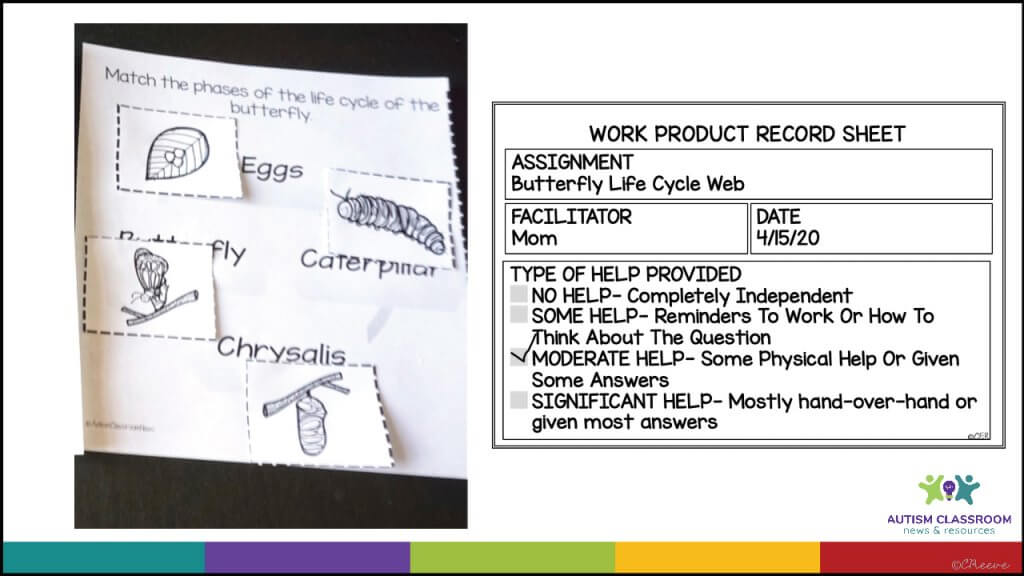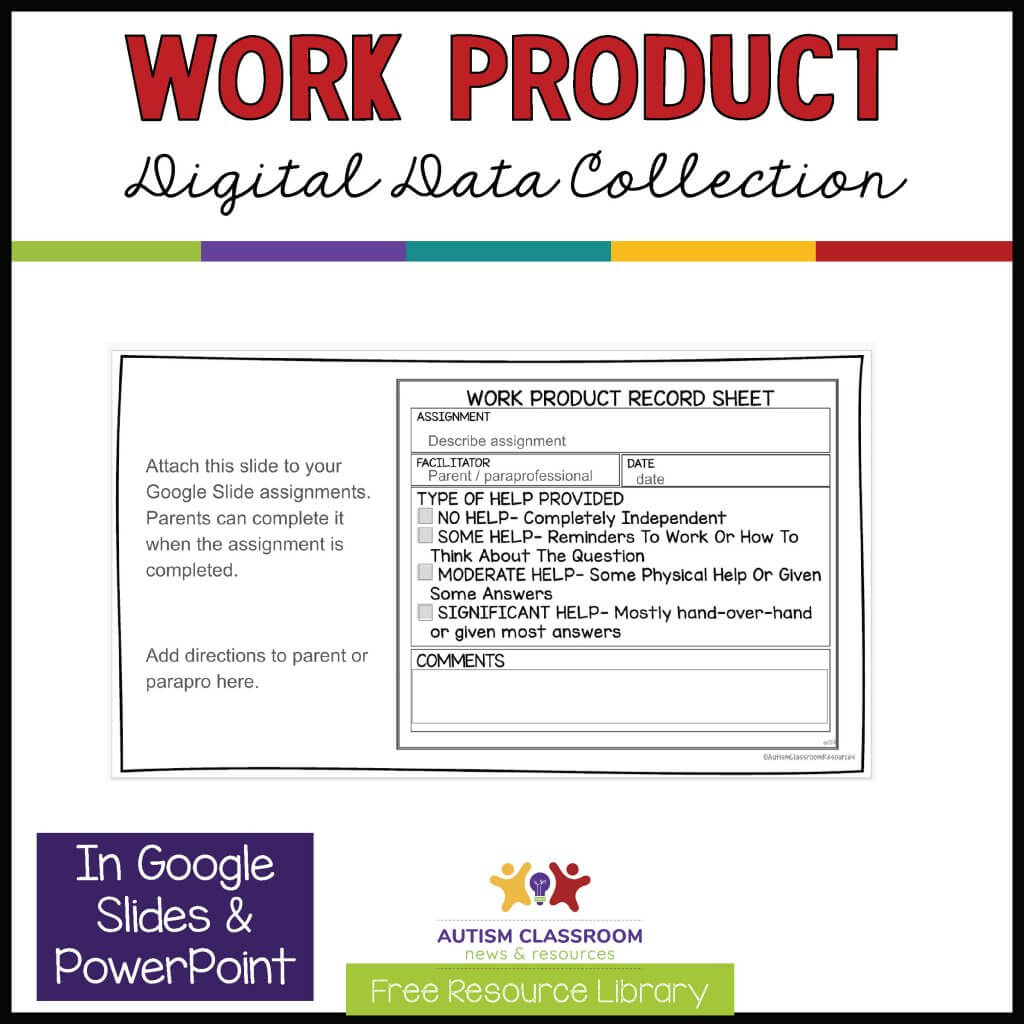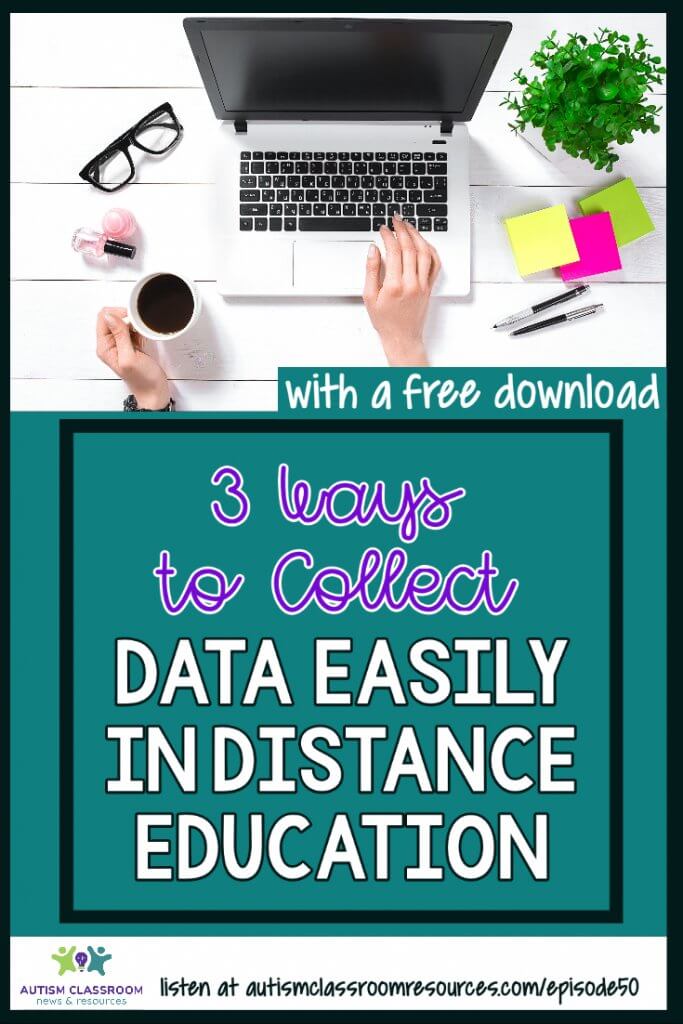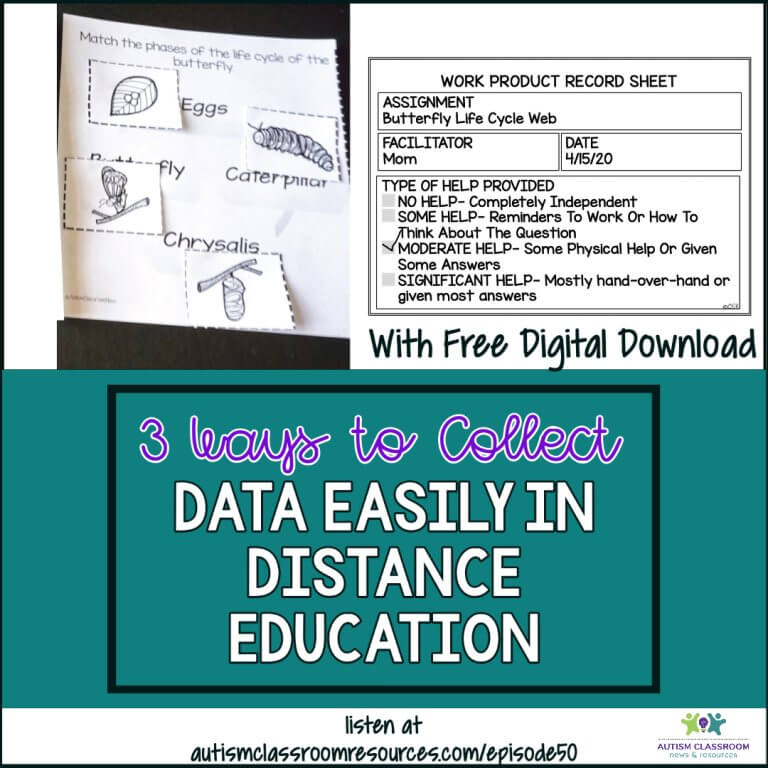Finding ways to monitor progress in distance learning for special education students is one of the questions I hear most frequently these days. We usually take data hands-on in the classroom, observing the student directly. And educators usually have control over (to some degree) the environment and conditions under which they observe the skills and behavior being monitored. But that’s not the case in distance learning, where the student is at home and frequently being facilitated by family or caregivers. So, how do we get the data we know we need?
Why Is It Important to Monitor Progress in Distance Learning?
We need to monitor progress for a variety of reasons. Yes, we definitely need data for legal reasons and to make the district happy. But more importantly, we need it to guide decisions about how instruction is conducted. We need it to know whether what we are doing is working. And if it’s not working, we need to be able to make changes.
Hurdles to Monitoring Progress in Distance Learning
Data collection is often the biggest hurdle faced in the classroom on a good day. With everything going on right now, many are struggling with it more. I hear the struggles regularly along the lines of the following.
- If I can’t observe the student doing the work, how do I know it was done independently?
- His parents are having hard time letting him try things independently, so all the data shows prompting.
- I got the assignment back, but how do I know if he had help?
- The families are already stressed. How do I teach them to take the data I need for monitoring?
- The IEP requires careful monitoring I just can’t do at a distance.
- and more
How Can We Take The Data We Need?
Yes it is difficult to monitor progress in distance learning. I don’t have all the answers, but I do have some tools and ideas that will help. So in this episode I will talk about 3 straightforward ways that you can use to get the information you need for monitoring progress. I think we have to really think about the information we need, and sometimes it’s rethinking.
And I have a free download in the Resource Library that I’ll describe below that can help lessen the load.
#1 Use Permanent Product to Monitor Progress in Distance Learning
Permanent product is also called work product. It’s when a student completes a physical item we can look at and analyze to get data. Having the student’s work product allows us to see what he did. But the key with work product in distance learning, and in the classroom, is that we need to know what type of support the student had.
As an example, if Kai completes a sorting task on Google Slides, we can look at how many items he sorted correctly and how many he got wrong. So we can get a percentage of correct responses. But, we still don’t know if he did it independently. Did his caregiver help him? Did someone correct his work when he finished?
Everybody Wants to Help
Let me address this just a bit here before we move on. Part of the concern with data collection in distance education is that we don’t know if someone helped the student or corrected his work. This isn’t unique to work being completed at home in distance learning. It’s true with the paraprofessional working with the student in a center in the classroom (when the teacher is running her own center). And many times we can’t observe the paraprofessional’s instruction.
[socialpug_tweet tweet=”Part of the concern with data collection in distance education is that we don’t know if someone helped the student or corrected his work. This isn’t unique to work being completed at home in distance learning. #distancelearning” display_tweet=”Part of the concern with data collection in distance education is that we don’t know if someone helped the student or corrected his work. This isn’t unique to work being completed at home in distance learning. ” style=”2″]
So it’s clear that many staff with who have training and monitoring don’t always realize how much they are helping a student. Let’s add being the student’s parent. Having a sister with autism, I’ll be the first to say that we all interact with our family members differently than we do our students. There is an emotional overlay and a learned history that impacts the interaction. That’s the same for families of our students.
Enter the Work Product Stickers and Google Slides
So, one way to know what type of assistance was given, and in what type of situation, is to add some type of documentation to the product itself. In the classroom, I use stickers with checklists for staff that can be attached to the work itself. For distance learning, I would use simplified checklists like the one below. Instead of using names of prompts we usually use in the classroom, I used typical ways people talk about helping someone (e.g., lots of help, not much help, on their own). It’s not as exact as our prompting might be, but it’s often enough to meet our need for information.

I used to use a stamp, but to get the information on it I wanted, it ended up being pretty expensive. These stickers can be printed on the computer. I use full page sheets and cut them because it was just easier than making sure they all lined up with the pre-cut labels. If you have my book Taming the Data Monster, you have free access to data tools with that and one of them is a label like this. Those labels were designed for prepared address labels. And if you have my Instructional Data Sheets, you have several versions of these.
Work Product Stamp Goes Digital
So what if you don’t have written paper going back and forth for digital assignments? How can you get this same kind of feedback? Easy Peasy–download the Google slide below with an embedded form. Copy it and paste it into the end of your Google Slide and families can complete it and send it back to you. Then you can check the assignment and know what type of assistance was given. You will still need to coach the parents on how to complete it and make sure you are on the same page about the type of help provided. However, it should at least give you some information to compare to other sets of data received from the family.
sign up for free tips each week in your inbox and Grab a free work product checklist digital slide from the resource library

Grab the free Work Product Record Sheet Slides in PowerPoint and Google Slides from the Free Resource Library. Click below to navigate or join the free library.
#2 Use Tests (or Probes) to Monitor Progress in Distance Learning
If you are an educator, you call them tests. If you are a behavior analyst, you might call them probes. Either way they are a way of checking on progress through observing the student without assistance (or with only specified assistance) and measuring performance. Tests are an easy way to regularly monitor progress and of course it’s what’s used in most general education situations. You can do tests/probes during video conferencing time as way to regularly monitor progress.
Tips for Using Tests
A couple of thoughts about using tests in distance learning. First, talk to the parents about how to best support their student during the test. As I noted earlier, parents may have a difficult time watching their child struggle with tasks and they may be eager to jump in. Part of distance learning with families as facilitators is going to have to include training and coaching for them from you to resist that impulse. I have a whole workshop on coaching parents in distance learning in the Special Educator Academy and could spend all day on how to do it, so I won’t take that time now. But have these conversations with families before you do the testing and consider having them not help the first time and then, if the student can’t do the task, let them assist and record it that way.
Your can use tests to directly observe the skill directly and take your data. Probes don’t have to be formal tests you create for the student. It could just be a brief instructional session you complete with the student and tell the facilitator it’s a test. That way they know not to help and you get regular data. You can also use benchmark testing and content testing from formal curricula, like the Unique Learning System, to check in regularly with students’ progress.
#3 Simplified Rubrics, Ratings and Checklists to Monitor Progress in Distance Learning
Families are unlikely to have time and energy to take the more intensive data that we use in the classroom. And not everything you need data on is going to be available to observe in a video conference. So, there are going to be times you need some overall assessment of the student’s behavior, social performance, or executive functioning in completing work independently. Simplifying your rubrics or rating scales currently used in your classroom can help.
Tips for Using Rubrics at Home
To simplify them, you can do something similar to what I talked about with the work product data above. Use lay terms to describe levels of help provided. A sample rubric or rating scale might look like the example below.
| 0 | 1 | 2 | 3 | 4 |
| No success, even with help | Needed hand-over-hand or gave most of the answers | Gave a few answers or clarifying questions or some hand-over-hand | Needed reminders to stay on task or help with 1 or 2 items | Independent success—didn’t need any help at all |
Make sure to have the facilitator complete a rubric on a regular basis. It might be daily or weekly, but build a routine that helps them remember to complete it. It might be something you put in the lesson plans you send home to be done every Wednesday or Friday. Don’t forget that we all need reminders. And with everything going on, that is certainly no different for families.
Tools to Monitor Progress
So, let’s recap 3 tools you can use to monitor progress in distance learning. Monitoring work product using a check-off form completed by the facilitator is a quick and easy way to get information about what type of help a student is needing for their asynchronous work (when you aren’t watching). Don’t forget to grab your free PowerPoint and Google Slide tool for that above.
Tests are a second tool you can use regularly to keep an eye on how a student is progressing in particular skills. Some may already be made for you as part of a curriculum and some can be informal observations during your video conference time.
And finally, consider using rubrics and rating scales with simplified responses for families to use to monitor behavior, social skills and other more qualitative skills measurements. You could even use them in checklists for skills the family needs to integrate with their routines. Examples of those skills might be life skills activities done at home, independence at completing work, or greeting family members in the morning.
Resources to Monitor Progress
All of the tools I’ve talked about in this episode have been modeled on the types of tools you’ll find in my Instructional Data Sheets set. The data sheets in that set are editable in PowerPoint to add your own steps and personal information. You can’t change the structure of the sheets, but there are lots of options of each available. Find out more about the instructional data sheets for monitoring progress in this post.
And we have a whole course on Taming the Data Monster in the Special Educator Academy. Plus we have a workshop specifically on monitoring progress in distance learning with tools to implement it. If you have ever struggled with the rapidly changing world of education these days, or felt like you just needed more support or ideas, come join us in the Special Educator Academy with a 7-day free trial by clicking here.






